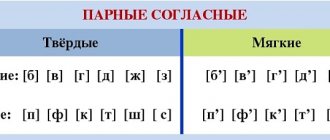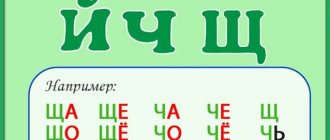Publicity of sounds
Vowels are a type of sound during which the air flow through the larynx or nasal cavity is unobstructed. The vocal cords are vibrated by an air stream. At this moment they are tense and shifted.
REFERENCE! Vowels are sometimes called “mouth openers” because they require you to open your mouth wide to pronounce them louder. This distinguishes them from consonants - “mouth-closers”, because in order to make them louder, you need to bring the organs of the mouth as close as possible.
Vowel differentiation is achieved by changing the shape of the resonator. This could be a change in body position or the root of the tongue or lips. In the languages of the world, nasal articulation and phonation are also possible.
Consonants and sounds in Russian
Vowels and consonants letters and sounds vary significantly. And if the first ones can be easily pulled out, then the latter ones are pronounced as briefly as possible (except for hissing ones, since they can be pulled out).
It should be noted that in the Russian alphabet the number of consonant letters is 21, namely: b, v, g, d, zh, z, j, k, l, m, n, p, r, s, t, f, x, ts, h, w, shch. The sounds they denote are usually divided into dull and voiced. What is the difference? The fact is that during the pronunciation of voiced consonants, a person can hear not only the characteristic noise, but also his own voice (b!, z!, r!, etc.). As for the deaf, there is no way to pronounce them loudly or, for example, shout. They only create a kind of noise (sh-sh-sh-sh-sh, s-s-s-s-s, etc.).
Thus, almost everything is divided into two different categories:
- voiced - b, c, d, d, g, z, j, l, m, n, r;
- deaf - k, p, s, t, f, x, c, ch, sh.
Formation of vowel sounds
Any sound begins with the release of air from the lungs, then it is directed to the larynx and exhaled through the mouth or nose.
When we pronounce vowel sounds, our vocal cords in the larynx - two soft folds of muscle - vibrate. In normal breathing mode, this organ is in a relaxed state. If the ligaments are stretched and brought closer together, forming a narrow gap between them, the air flow causes vibrations.
Then the air stream formed by the voice passes freely and unhindered through the oral cavity. Thus, a vowel sound has tone, but there is no noise in it.
The specificity of the sound of a single vowel changes depending on the position of the tongue and lips, that is, on articulation.
REFERENCE! Articulation is the movement of the pronunciation organs when producing sounds.
Stressed and unstressed vowel sounds
There are strong and weak vowel positions. They correspond to their stressed and unstressed positions.
The clear pronunciation of a stressed vowel is contrasted with the reduction of unstressed vowels. In a weak position, articulation is less distinct, the duration and quality of sound is reduced.
REFERENCE! This is associated with errors in the spelling of unstressed vowels in words. For example, in the word “street”, [and] is unstressed and is heard as something between [and] and [e].
The reduction is not the same for different sounds. It is also directly proportional to the rate of speech: the faster the speech, the greater the reduction.
Thus, in Russian, the strong position of vowel sounds makes the differences between them more obvious.
Yotated vowel sounds
Six vowel sounds correspond to 10 vowel letters of the Russian alphabet, 4 of which are formed by a pair with a consonant [y'] - ya [y'a], e [y'e], yo [y'o], yu [y'u]. In syllables and words, these iotated letters indicate the corresponding vowel sound coming after a soft consonant: forest [l'es], ball [m'ach'], and so on.
Stressed and unstressed vowels
The vowels in a word are pronounced differently. Only one vowel is always emphasized by the voice and sounds longer than the other vowel sounds, for example in the word:
dog
In the second syllable, the vowel sound indicated by the letter “a” sounds with particular strength and duration.
It is in a strong position and sounds clear and crisp. This vowel sound is stressed.
Let's observe:
- peaceful
- city
- smile
- drawing
In Russian, the strong position for vowels is the stressed position.
The remaining vowel sounds are in a weak position without stress. They sound less clear and are subject to changes during pronunciation. Such sounds in a weak position are called unstressed vowels. To correctly write a word with an unstressed vowel, you will need a test word for it.
Distinctive features of vowels
Vowels differ from each other due to the nuances of sound formation. As a rule, this is due to the position and mechanism of operation of the resonator - limited by the shape and size of the physical body in which the air produces resonance.
The largest resonator is the oral cavity, so it is this part of the speech apparatus that greatly influences the quality of sound. The shape of the oral cavity changes in response to changes in the vertical and horizontal position of the tongue.
The lips are responsible for the shape of the hole through which the air stream passes. This also affects the sound and is called labial articulation or labialization (translated from the Latin labri - “lips”).
REFERENCE! Differences between vowels are necessary for them to perform a semantic distinguishing function.
Climb
The rise is determined by the vertical position of the tongue body. He can be:
- upper - the back of the tongue comes closest to the palate. This rise forms closed vowels: [i], [s], [u].
- Middle-upper - the tongue rises to 2/3 of the oral cavity, forming half-open vowels: [e], [o].
- Middle-lower - sounds are pronounced with the lower elevation of the tongue (by 1/3). It corresponds to half-closed vowels.
- Lower - the tongue remains motionless. As a result, open vowels are pronounced: [a]
IMPORTANT! Not all languages recognize all four rises. For example, half-closed vowels are not found in Russian speech.
Row
The vowel series is determined by the horizontal movement of the body of the tongue. Depending on the position it can be:
- anterior - the tongue is as close to the teeth as possible ([i], [e]),
- middle - the tongue occupies a middle position, i.e. remains without movement ([a], [s])
- posterior - the body of the tongue produces sound in the back of the larynx ([u], [o]). Sometimes back vowels are called “dark”.
IMPORTANT! In case of speech defects, anterior articulation [y] and [o] is possible. This occurs if the tip of the tongue is close to the front lower teeth, and the back of the tongue is arched. As a result, in words where hard vowels are pronounced according to the norm, they are softened.
For example: instead of “pol” [pol] - [p'ol], instead of "remote" [pul't] - [p'ul't]. In addition, excessive protrusion of the tongue when pronouncing the sound [e] until it touches the lower lip appears as a case of exaggerated articulation.
Roundness (labialization)
The shape of the resonator - the oral cavity - can also be changed using the lips: by “protruding” them forward (in the form of a tube) or by rounding them. An example of the first method of labialization is the Russian sound [u], the second - [o].
REFERENCE! Together with these vowels, the consonant sounds that precede them are labialized.
It is noticed that only the back vowels are rounded, while the sounds of the front and middle row remain unlabialized.
Nasalization
The Russian language uses articulation through the oral cavity. However, in other languages, nasalization is used - an articulatory technique in which the soft palate (velum) is lowered and air is released through the nasal cavity.
Thus, the nose acts as an additional resonator. Examples of nasalization are common in English and French.
Nasal vowels are opposed to oral vowels (oral, pure, simple), formed with a raised soft palate without the participation of the nasal cavity.
REFERENCE! In the Russian language, nasalization occurs as an articulatory defect - nasality.
Phonation
Phonation is the production of sound using the larynx. Sound quality is determined by the tension and position of the vocal cords.
The mechanism of action can be described as follows: at the exit from the trachea, a stream of air passes through the larynx and the vocal cords located in it. The following development options are possible:
- If they tense and come together, the exhaled air causes vibration. This is how a tone arises, which is required for vowels and voiced consonants.
- Relaxed vocal cords and spread arytenoid cartilages allow air flow to pass without hesitation. As a result, there is no tone, which is typical for the pronunciation of voiceless consonants.
The extreme positions of the vocal cords are called the modal voice (vibration with maximum amplitude) and the laryngeal stop (full reduction).
Usually, free vibration is necessary for the articulation of vocal vowels, however, in the practice of world languages there are cases:
- squeaky voice (Vietnamese),
- voiceless vowels (Japanese).
Tongue root position
The difference in the sound of vowels in some cases is influenced by the position of the root of the tongue:
- pushed forward
- pushed back.
REFERENCE! The contrast between such articulations is not always obvious, except in a number of West African languages (Bambara, Hausa, Yoruba, Djerma, etc.)
Additional articulations
The types of phonations considered do not exhaust the entire variety of possible narrowings in the vocal tract.
For example, in Even, Ket, Tofalar and dialects of the Tuvan language there are vowels formed as a result of narrowing of the pharynx. Such sounds are called pharyngealized. In some cases of pharyngealization, vibration occurs not in the vocal cords, but in the epiglottis.
Erization
The term is derived from the name of the letter k (“er-”) and the suffix “-ization.” In practice, it means adding the suffix er to a word or syllable. This is typical for English and Beijing Chinese. Erization performs a meaning-forming function
When articulating, the technique is expressed in a slight bend of the tip of the tongue back when pronouncing vowels.
"Tension"
Depending on how strong the articulation is, there are:
- "tense" or cardinal vowels,
- "unstressed" vowels. In order to pronounce them, the articulators do not reach the extreme points of position and the sounds remain in the intervals between different rows and rises.
REFERENCE! This quality is not always identified as a phonetic feature; most often it is attributed to a phonological nature.
Longitude
Longitude is a characteristic of sounds that differ in longer or shorter duration relative to each other. In accordance with this feature, short and long vowels are distinguished. Long vowels are indicated using a colon - [aː], [oː], [andː]
In modern Russian, longitude-shortness does not have a meaning-forming meaning, so often a long vowel is perceived as stress or unusual intonation (for example, the exclamation: “Maaaam! It’s blowing me”).
IMPORTANT! A stressed sound is always longer than an unstressed sound. The sound located as the second pre-shock sound, on the contrary, is the shortest.
For example, “Valentine” - contains short [a] and long [and:]
In addition, longitude is characteristic of double sounds, that is, formed by two identical vowels at the junctions of morphemes (surnames, realities, herbariums - [and:] at the end).
The meaningful role of long or short vowels is obvious in the English language. For comparison, here are pairs of words that are different in spelling but almost identical in sound:
- live - leave,
- dock - dork,
- bins - beans,
- ship - sheep
Shva
Sheva (meaning “nothing” in Hebrew) is a vowel sound produced without special articulation. When pronouncing it, the articulators do not make any significant movements and the sound remains neutral. When parsing phonetically, it is indicated by the symbol [ə].
The seam is located in the middle row of the middle rise. It sounds like a cross between [a], [e] and [o].
REFERENCE! As a rule, it is located in an unstressed position, characteristic of the endings of nouns of the 1st declension: “cow” - [ka′rovə], “dog” - [sa′bakə].
Acoustics
When considering the acoustic properties of sounds, the following vibration characteristics are analyzed:
- frequency, which determines the pitch of sound;
- amplitude, responsible for its strength;
- a combination of different vibrations that affects timbre.
Acoustic classification is dichotomous, that is, it identifies pairs that are opposite to each other. From this point of view, vowels:
- all are vocal, as they are formed by tone;
- all are non-consonant, that is, they are characterized by greater strength than consonants;
- all are continuous;
- the front vowels ([e], [i]) are high, and the middle and back vowels ([a], [o], [u] [s]) are low;
- vowels of the lower and middle rise ([a], [e], [o]) are compact, that is, their vibrations are relatively close to each other, the vowels of the upper ([i], [ы], [у]) are diffuse;
- rounded vowels [o], [u] are flat, unrounded vowels [a], [e], [i], [s] are non-flat.
Phonology
Phonology (from the Greek “sound” and “teaching”) is a branch of linguistics devoted to the study of the structure of the sound structure of a language and the functioning of sounds in the language system.
If we take a vowel sound as a phoneme - a unit of language that does not have independent lexical and grammatical meaning - then its functions are obvious:
- act as the core of a syllable, that is, its obligatory element. In some languages, sonants or obstruents take on this role.
- bear emphasis, that is, highlight words within a word;
- determine tone, that is, use pitch to differentiate meaning within words or morphemes.
How to make money if you know Russian
If you are ok with spelling and punctuation (or generally ok, despite minor shortcomings), you can make money on the Internet from texts.
At first, the income will be small - 40-60 rubles. per page, but gradually you will find your niche and earn at least 200-400 rubles. per page. This is really true, because I myself have walked this path, from text exchanges where they pay pennies to individual cooperation with webmasters.
If you don’t know where to start, come to the “Copywriting from Scratch” course, which we created with Vasily Blinov. We will tell you in simple words what copywriting is in principle, how to correctly write articles on the Internet, how to do optimization, and carry out semantic analysis of texts.
The course includes five practices - you will write articles for the websites vsvoemdome.ru and iklife.ru. We pay for each practice. Students who complete the course pay back half of its cost and have 5 texts in their portfolio published on thousands of blogs.
Sign up for the course “Copywriting from scratch”
Diphthongs and Triphthongs
Depending on whether the acoustics of a sound changes during its articulation, there are:
- monophthongs,
- diphthongs,
- triphthongs.
Monophthongs are integral and do not break down into elements. Diphthongs and triphthongs, on the contrary, contain transitions from one sound type to another (and a third).
REFERENCE! In turn, they can be descending (the top of the syllable is the first vowel), ascending (the top of the syllable is the last vowel), and ascending-descending triphthongs occupy an intermediate position.
Russian vowels are predominantly monophthongs. Exceptions are iotated sounds corresponding to the letters i, ё, yu, e. However, if they are paired with consonants, they denote a monophthong and only soften the preceding sound.
For example: “I sing” [poy'u] or “yula” [y'ula], where [y'y] is an ascending diphthong; but in the word “love” [l'ubof'] there is no diphthong.
Thus, vowel sounds are represented in the world's languages in all their diversity. Some of their characteristics are inherent in Russian-language speech, others are expressed only as articulatory defects.
Related posts:
- Rhoticism in speech - complete information Rhotacism (problem with the sound [P]) is the most common disorder in children...
- A child does not know how to say R - we’ll show you how to teach it. To teach a child to pronounce the letter R, you need to regularly perform special...
- What do we know about Morse code? Morse code was created to transmit short information. But use...
- Teaching a child to read Teaching reading in preparation for school. When can you teach a child...
Types of vowels (as taught at school)
At school, these sounds are divided into two large groups:
- Shocks - the stress falls on them in the word, so it’s easy to determine the shock sound by pronunciation: saber, pillow, bird - A, U, And in these words there are shocks.
- Unstressed - all other vowel words, the stress does not fall on them. For example, in the word box the first O and the last A are unstressed.
When we stress a vowel, we pronounce it for a long time. Longer than all other sounds. Therefore, the drums are heard very clearly and do not cause difficulties in writing. Except when they are found after sibilants and c.
But with unstressed ones everything is more complicated. Because they are not stressed, we shorten them and even change them. And then we can’t understand what letter to write. A spelling appears.
Read a separate article about unstressed vowels, everything is described there in detail, tips are given on how to easily and quickly understand all spelling rules.
Soon I will post a selection of the best courses for preparing for the Unified State Exam and preparing for the Unified State Exam. Among them there will be paid and free programs, reviews of discounts and special offers. Subscribe to updates - I will send you an email as soon as the article is published.











